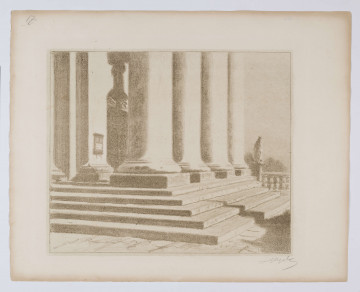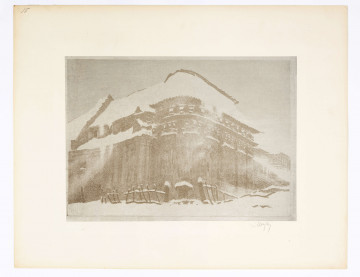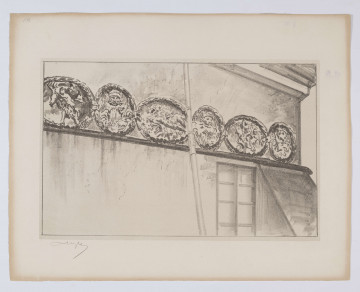
Pediment of the cathedral in the moonlight
1918 — 1919
National Museum in Lublin
Part of the collection: Lubliniana. Painting views of Lublin and the Lublin Region (17th–early 20th c.)
The portfolio Lublin belongs to the mature graphic works of Leon Wyczółkowski (1852-1936), who devoted over thirty years of his artistic activity to graphic arts, abandoning oil painting in its favour. He became interested in the graphic medium around 1900. Already as a mature, recognised artist he began to analyse the technical possibilities of etching, aquatint, algraphy, fluorophores and, above all, lithography. Thanks to the similarity of the effects of a lithographic print to drawing and painting and the possibilities for experimentation that best suited Wyczółkowski's preferences and temperament, lithography became the artist's favourite technique. He published cycles of graphic works in low-cost portfolios devoted to the landscape and architecture of Polish cities. In his panoramic city views, shots of historic buildings and meticulously recreated architectural details, he combined documentary skills with an extraordinary passion for individual feeling of architecture. The portfolio Lublin is one of the most beautiful graphic portraits of the city, which the artist supplemented with three boards unrelated to architecture. These include views of trees: two versions of Sosenki [Pines] and Stara Lipa w Piotrawinie [Old Lime Tree in Piotrawin]. Wyczółkowski prepared the drawing sketches during his stay in Lublin in 1918. Composed of seventeen auto-lithographic boards, the portfolio was published a year later in Kraków in twenty copies. After printing the edition assumed by the artist the lithographic stones were destroyed, which in Wyczółkowski's case was a frequent practice and gave his prints a unique character. In plate number 6, which precisely copies an earlier pencil sketch depicting a fragment of the Bernardine Monastery and Church, Wyczółkowski used a surprising framing of the composition, which reveals the typical for his mature graphic art passion for architectural detail. The artist's attention was attracted, first of all, by the structure of the baroque gables of the monastery in the form of semi-circular closed niches, pilasters and volute gables, which he outlined with a precise line, revealing the details. The flexibility of the line coexists with broad strokes of crayon in the chiaroscuro developed surfaces of the walls, giving the composition a painterly character despite the lack of colour.
Anna Hałata
Author / creator
Dimensions
cały obiekt: height: 46,6 cm, width: 30,5 cm
Object type
graphics
Technique
crayon lithography
Creation time / dating
Creation / finding place
Owner
The National Museum in Lublin
Identification number
Location / status

1918 — 1919
National Museum in Lublin

1918 — 1919
National Museum in Lublin

1918 — 1919
National Museum in Lublin
DISCOVER this TOPIC
Castle Museum in Łańcut
DISCOVER this PATH
Educational path